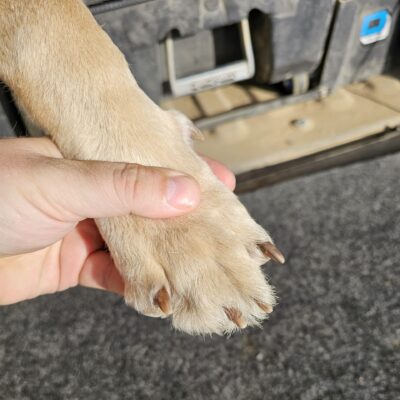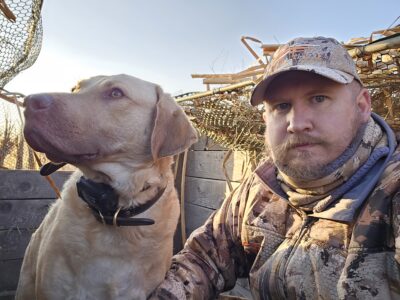Everett Headley 11.14.23

Upland and waterfowl seasons are upon us across the flyways. The spring and summer training sessions spent with our dogs are now culminating in retrieves and hero shots. After the hunt, birds are dressed, shotguns stored, and your canine companion gets dinner. However, if any of these are left underserved, you’ll find spoilage, rust, and a lame dog. I’ve made it a habit that after every outing, while still loading up at the truck, I give my Chesapeake Bay Retriever Cane a short physical. He can hide pain better than any other dog I’ve owned and little things have a tendency to fester into bigger issues with vet bills to match. If you follow the steps below you’ll find a methodical approach that will become second nature.
Start with the head.
Our dogs will bound through reeds or rushes headfirst giving little thought to potential injury. A sharp quick poke could easily become infected if not cleaned and dressed. I look for clarity in the eyes and anything foreign that might be hiding under an eyelid. I move on to the ears where seeds can make their way into the canal. Cheatgrass is notorious for getting lodged and causing an infection. The ears should be clean and free from a red or irritated appearance. Gently open the dog’s mouth to look for a broken or dislodged tooth. This is also a good time to check their hydration by pressing on a gum and looking for it to pink up quickly. Close the snout and peer into the nostrils, again checking for anything strange.
Move down the body.
Run your hands down the neck while scrunching up the skin. Feel for any debris in the coat or abnormal bulges underneath. As you continue down the back, feel the vertebrae and ribs by pressing down with just enough force to move the body slightly. Working dogs are tough and an audible yelp will often not be uttered. Watch for facial cues or backing away after a touch. This is often the only response that a closer inspection is needed and can be subtle. Keeping one hand on the dog’s collar, use the other to squeeze the tail to the tip in small steps. A quick smooth down of ruffled hair can help you feel for any ticks or parasites that might have been picked up.

Check each leg.
Dogs can be particular about letting a foot be picked up and examined. To make sure I don’t miss one, I start with the front right and move clockwise around the rest. Bring the foot up to the body and back down again. It should move easily with a full range of motion. Examine the pads, nails, and webbing for blood or impalements or a broken tip. Press on each toe to see it extend properly. Also make a note if a nail trim will be needed later.
Don’t forget the undercarriage.
Standing a dog on a tailgate and lifting a hind leg is the easiest way to complete the last step. It exposes the belly for a closer inspection. Palpate the belly for anything unusual. Look for any red or irritated blotches which could indicate a skin infection. Check the reproductive areas, again looking for anything not normally present.
Get the overall picture.
Recall the hunt and how your dog behaved. Dogs are creatures of habit and behavioral changes are often the first symptom of something underlying. If the hunt was exceptionally hot or cold, watch for signs of exhaustion and hypothermia. We are the first line of protection for our dogs and knowing what local environmental concerns they could be exposed to is our responsibility. I found out after another expensive vet visit that “pot dog” is a real and increasingly common result of a dog eating a discarded amount of marajuana. Regularly check in with your vet for any current issues you might need to be aware of this season.

After a few outings and this will become a standard part of your routine, taking only a couple of minutes before you head for home. Your dog will become accustomed to it and, if it’s like mine, appreciate any extra moment of attention. If anything seems out of place, the best practice is to check with your veterinarian. And my standard disclaimer: I’m not a veterinarian myself.

